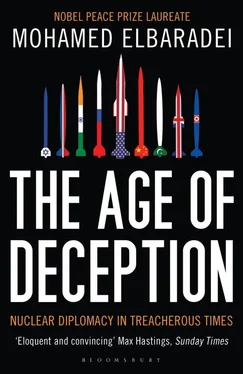The forum was also an opportunity to meet with Swiss president Micheline Calmy-Rey and State Secretary Michael Ambühl, who were also seeking independently to bring Iran back to negotiations. For two years, I’d been working closely with Calmy-Rey and her team, sharing ideas on possible paths to compromise with Iran on its enrichment program. The Swiss were eager to see a peaceful resolution of the Iran nuclear file and since they represented the U.S. diplomatic interest in Tehran (the U.S. “interest section” in Iran is part of the Swiss embassy), they had a legitimate role to play as an intermediary.
One idea I put forward in Davos was whether Iran could simply stop feeding nuclear material into the centrifuges. This is referred to as “warm standby”: the machines continue to spin but without feedstock. I was not sure if the Americans and others would accept the proposal, which would allow me to report that Iran had suspended enrichment as requested by the Security Council and was only conducting R&D. The Swiss agreed to explore the idea with Iran.
A chaotic few weeks ensued, with a frenzied cycle of phone calls, meetings, and brainstorming sessions with various parties. I moved back and forth between Rice and others from the United States, trying to find some way for them to join the dialogue, and Larijani and other Iranians, seeking some form of suspension that would be acceptable on Iran’s domestic front.
The Swiss kept up their efforts at shuttle diplomacy. Ambühl met with Larijani in Tehran. Calmy-Rey invited Larijani to Bern. Kislyak called to say the political directors of the P-5+1 seemed supportive of “ElBaradei’s proposal,” as they called it. Mohammad Saeedi, Gholamreza Aghazadeh’s deputy, stopped by for clarification about the possible benefits of agreeing to a time-out to help convince the Iranian leadership. Sweden’s foreign minister, Carl Bildt, came to see me, as did Kim Howells, minister of state in the British Foreign Office.
Everyone wanted to get involved. Everyone wanted the same thing. But no one seemed able to find a way to talk sense into the hard-headed conservatives at opposite ends of the equation.
I reshaped the four “principles for negotiation” once again, trying to tailor them precisely to address the core concerns holding both sides back: trust, transparency, and future intentions. Now there were just three principles. First, explicit acknowledgement by all parties of Iran’s right to have the nuclear fuel cycle, including enrichment, with recognition that the focus of the time-out was only on the timing and modalities for exercising that right, to create a sufficient opportunity to rebuild trust in the international community regarding Iran’s intentions. Second, a commitment by Iran to working with the IAEA, in full transparency, to resolve any outstanding verification issues. And third, a commitment by both sides to work toward full normalization of relations between Iran and the West, including in the political, security, and economic fields.
I began peddling these three principles to the various diplomats working on the issue, including to Larijani. In a February meeting in Vienna, he said the principles seemed fair and should be put in writing. However, suspension, whether in the guise of a time-out or not, was in his view secondary. The primary issue was the distrust between Iran and the other parties, chiefly Europe and the United States. He cited a statement by Tony Blair made during a recent visit to the Gulf, that the West was building a coalition of moderate Arab countries against Iran. [5] Daniel Dombey, “Blair Seeks Closer Ties with Moderate Arabs,” Financial Times , December 20, 2006.
These kinds of pronouncements stirred up old suspicions: Larijani recalled Blair saying in 2003 that the only reason Iran was cooperating with the IAEA was a result of the war in Iraq—because the Iranians saw that the West was “serious” and the Iraq War had been a “test case.”
These sentiments, Larijani said, undermined every attempt at progress. As long as the West viewed Iran with such distrust, the haggling over suspension was meaningless.
“There are reasons for the distrust,” I said, mentioning Ahmadinejad’s statements about Israel and the Holocaust.
This was now “under control,” according to Larijani. During Iran’s celebrations on February 11, Revolution Day, Ahmadinejad had omitted any proclamations about their nuclear program, he pointed out.
Larijani wanted the Americans to understand as well that Iran hoped the al-Maliki government in Baghdad would succeed: the Iranians were not supporting the Shi’ite al-Mahdi militia led by cleric Moktada al-Sadr. Democracy and stability in Iraq was in Iran’s interest. Larijani asked me to convey these thoughts to Condoleezza Rice. “She seems to be a person who understands,” he said.
The P-5+1 and Solana came back with their response to the time-out idea in late February. John Sawers called to say that they would adopt a statement based on the three principles and the idea of a double timeout, but they intended to pursue a dual-track strategy and push for another Security Council resolution, with additional “limited” sanctions. The news of another Security Council resolution being in the works dismayed Larijani. “If that goes forward,” he said, “it will be the end of the negotiating process.”
A conversation with Rice about the Iran situation gave me the chance to urge her to consider the sequencing of the P-5+1’s strategy. First, I heard her view on the three principles: she was not keen on the word normalization , nor on explicitly spelling out Iran’s right to enrichment. Otherwise, she had no problem with the idea of a “simultaneous timeout.” This was encouraging. But I told her that going directly to the Security Council to push for sanctions would make it hard for Iran to come to the negotiating table. “You would be better served by airing these ideas with Iran first, before resorting to more sanctions,” I said. Otherwise, “you will be empowering the hard-liners and undermining the moderates.”
Rice seemed to be listening carefully. Sometimes the way she asked questions, when I suspected she already knew my answer, gave me the impression that our conversations were being recorded and transcribed. The Bush administration was, from what I could tell, fractured internally on foreign policy matters. Rice needed to marshal every argument if she was going to convince Washington’s skeptics about reaching out to the Iranians. Maybe she wanted them to hear directly what Larijani had said about Iran’s interest in talking to the United States. It was hard for me not to speculate.
Feeling like a broken record, I repeated that she should try to engage Iran directly. “It will help you on Iraq and also on the nuclear issue,” I said. The Iranians were talking to the Saudis about Lebanon and Palestine. “People like Larijani,” I told her, “are sincerely interested in dialogue.” Rice did not disagree but neither did she commit herself.
Two days after we spoke, Washington announced that the United States would participate in a conference on Iraq with “neighboring countries,” including Iran and Syria. The Americans insisted they would talk only about Iraq, not about the Iranian nuclear issue. The hair-splitting sounded a little childish to me; but I wasn’t about to quibble. It was one step forward.
• • •
Any optimism I felt was fleeting. The opening of one door was immediately followed by other doors slamming shut. The P-5+1’s march toward another Security Council resolution, however futile, seemed unstoppable, especially since it appeared that neither the Russians nor the Chinese would exercise their veto. Nonetheless, there was a flurry of diplomatic activity aimed at halting the advance.
Читать дальше












